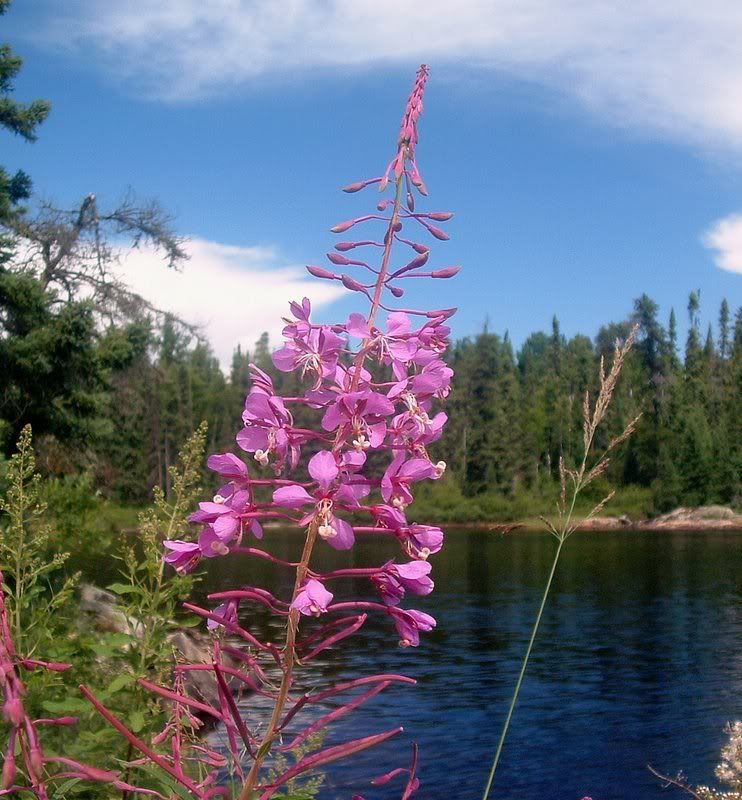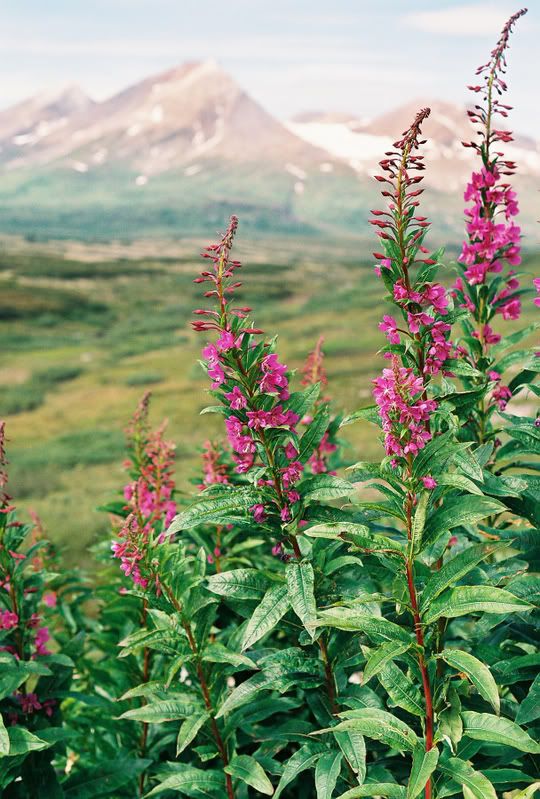
Fireweed grows abundantly here in Maine in blueberry barons,along roadsides and in old burn areas.
Epilobium angustifolium is synonymous with Chamaenerion angustifolium & frequently mispelled augustifolium. It is circumpolar in distribution beginning in the subarctic regions. Due to its extensive range it has a plethora of common names, but the foremost name is Fireweed.

Because it has willow-like leaves its second most common name is Willow Herb with sundry variants: Rosebay Willowherb, Bay Willow, Flowering Willow, French Willow, Persian Willow, Willow Weed, Giant Showy Willowherb, Great Willowherb (as distinct from the small alpine willowherb), Spiked Willhowherb, or Tame Withy (after willow withe). It is frequently called Blooming Sally, especially in Ireland, alluding to both the flowers, Sally being a corruption of the Latin Salix (Willow).
Both E. angustifolium & E. palustre are sometimes known as Wickup, Wickop, or Wicopy. It shares this name with Dirca palustris also known as Wicopy, Leatherwood, Moosewood, or Rope-bush. Both plants share in common that they were used to make twine or ropes or were woven with reeds or rushes to form tough mats. The name Wickup has the same proto-Algonquin origin as Wickiup or Wigwam, a hut covered with mats woven from just such plants.
It has been called Wild Asparagus because edible, & for its blossoms, Purple Rockets, Mare's Tail, & in Great Britain, Bloomi. It has also been called pileworts because of its medicinal use, though lesser celandine has a greater claim to that name. A recurring name that puzzles me is Blood Vine, because it never grows like a vine, though it does produce a great deal of sap (blood) that was used as syrup by Inuit people.
In Italy E. angustifolium is known as the Herb of Saint Anthony (Erba di Sant Antonio), while in Spain E. hirsutum has the same name (Yerba de San Antonio) & E. spicatum along with other species of Epilobium are called St. Anthony's Laurel (Laurel de San Antonio).
The association with the saint arose from a belief that Fireweed was the herb to treat Saint Anthony's Fire, a horrific disease of the Middle Ages caused by fungal poisoning from ergot-contaminated rye. It caused berserk rages, hallucinations, & a feeling of being burned at the stake, before fingers & other extremities began to black & drop off. It was believed that St. Anthony was able to cure this affliction, & Fireweed was one of the plants that peasant lore lit upon as Anthony's curative herb.

Fireweed is such a common wildflower throughout our county that there's even a Fireweed Road. It's beautiful in full flower almost as soon as the wild foxgloves have finished flowering in the same vicinities, & continues flowering throughout summer.
Flowers are followed by fluffy seeds dispersed upon the wind. Native peoples also mixed the fluff with dog hair or other animal hair to manufacture blankets, or just used the fluff to get fires started. In Europe fireweed fluff used to be mixed into cotton for the manufacture of stockings.
Fireweed is common along roadsides, meadows & clearings, edges of conifer & deciduous forests, sea level to sub-alpine levels, in wet or dry locations, & its one of the first wildflowers to appear in clear-cuts & burned areas. Indeed its common name Fireweed arose because it so quickly colonized areas that had experienced forest fire, both from the facility with which the seeds reach new areas, & because its thick rhizomous root system can survive forest fires. When Mount Saint Helen's exploded, a year later the Fireweeds were first to recover, turning the blasted hillsides purple.

This tough perennial ranges in height from four feet to eight feet, its yellow stems sporting purple flowers in tapered racemes. They are especially liked by bees & Fireweed Honey is available from our county on a pretty regular basis. It is a host plant for the North American yellow-banded sphynx moth (Proserpinus flavofasciata).
It is very widespread here & is the floral symbol of the Yukon. It also grows in northern Europe, where it became famous for springing up where soil had been cleared & disrupted by aerial bomb attacks during World War II. It even sprang up flowering amidst the rubble of the bombed inner city of London.
Some tribal peoples used fireweed medicinally to topically treat infected wounds. Modern herbalists regard it as an antispasmodic medication taken internally. In Europe it is still used to treat diarrhea & other bowel syndromes, & it is an ingredient of many commercially prepared alternative remedies for everything from cosmetic skin care to asthma to baldness to kidney disease.
FIREWEED & RED CLOVER

Many of its alleged values are false or exaggerated, but a good deal of authentic medical research has been done with Epilobium species of America & Europe, & it is in fact one of the more promising herbs. It has been shown to inhibit cell proliferation of the prostate [Vitalone et al, Pharmacology October 2003]. It is an effective antimicrobial [Battinelli et al, Farmacology May-July 2001], & it has several other potential values, possessing chemical components that are a proven anti-inflammatory.
Early season shoots are a delicacy harvested late spring or early in the summer. Shoots & young stems are peeled & can be eaten raw or steamed as a substitute for asparagus. Yupik eskimos preserved the stems in seal oil in order to have them year-round, & their name for Fireweed, Pahmeyuktuk, referred to its edibility. The peelings of the stems were not wasted as they were dried & used to weave strong twine for fishing nets.
Very young leaves are also edible in salads or in soups or steeped for use as a tonic tea for upset stomach. Mature leaves become tough & bitter, but by then the unopened flower buds are tasty for salads or in stir-fries. A syrup was traditionally extracted from the stems & flowers, having a high mucilage content that made it useful among native peoples in preparing berry-cakes that dry solidly. Today the flowers are harvested to make Fireweed Jelly, available from small cottage-industry canning companies including Native American companies.
Pioneer Alaskans used the sweet pith in the manufacture of ales & vinegars. As an intoxicating beverage it was rendered potently hallucinatory with the addition of Fly Agaric, Agaricus muscarius.

I really don't know if this grows in our area or not but will be on the lookout now.
ReplyDeleteVery interesting facts from this lovely plant!
I love you Sister! Hope you are having a good day...
Blessings and Peace!
xoxo
Thanks for your great information, the contents are quiet interesting.I will be waiting for your next post.
ReplyDeletejobs in life Sciences
I will miss seeing you
ReplyDelete